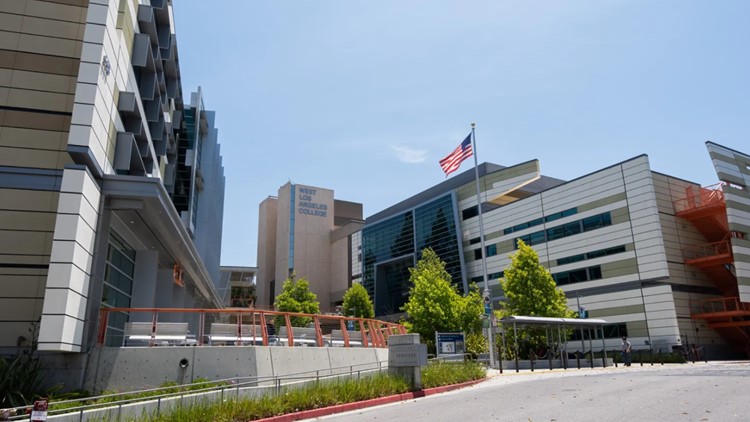CALIFORNIA, USA — This story was originally published by CalMatters.
The community college system is falling short of one of its most important benchmarks: the number of students who transfer to a four-year college or university. It remains well below the system’s own goal, and lawmakers have taken notice.
“Although most students intend to transfer to a four-year university, few do,” wrote a group of state legislators this year as they asked the state to audit community college performance.
Set in 2017, the goal was to increase the annual number of community college students who transfer to the University of California and California State University from nearly 89,000 to more than 120,000 by 2022. In the 2020-21 academic year, the most recent data available, nearly 99,000 community college students transferred to a UC or Cal State.
The Community College Chancellor’s Office responded to questions regarding the transfer goal by forwarding a letter that former interim Chancellor Daisy Gonzales wrote to legislators in March as part of an internal negotiation regarding the audit. In it, she wrote that the goal “has not been fully achieved.”
She wrote that the UC and Cal State system rejected nearly 30,000 eligible community college applicants in fall 2020 — more than enough transfers to meet the community colleges system’s goal. She wrote there was “insufficient capacity” at the UC and Cal State campuses and asked the auditors to include equal scrutiny of those systems, since everyone is mutually responsible for coordinating successful transfers.
However, there are many ways to measure transfer. To get a clearer picture, CalMatters looked beyond the chancellor’s office goal and analyzed the raw number of students who transferred every year, which includes but is not limited to those who transfer to a UC or Cal State. Those numbers are reported by four-year institutions across the country and analyzed by the California Community College Chancellor’s Office. Undocumented students are not counted because they lack a Social Security number. It’s the methodology that most closely aligns with the state’s funding formula, which pegs the transfer numbers to the amount of money a college receives.
CalMatters then compared those numbers to the total number of students who, upon starting community college, said they eventually wanted to get an associate degree or transfer.
Of the students enrolled in a community college in California who said they wanted to transfer to a four-year university, an average of 9.9% went on to enroll at a four-year institution in 2021, the most recent data available.
There are many reasons why students never transfer. The state’s roughly 1.8 million community college students are predominantly low-income, first-generation students of color. Many students, especially older students, must juggle work, children, and for some, even homelessness while attending school.
But certain populations and colleges have a harder time with transfer than others. CalMatters found:
- Students at rural community colleges are less likely to transfer to a four-year university than students who attend school in affluent parts of Ventura County, Orange County, the San Fernando Valley, and Bay Area suburbs like San Bruno, Pleasant Hill, and Redwood City.
- Colleges separated by only a few miles show stark contrasts in transfer rates. In 2021, the most recent year available, the transfer rate at Irvine Valley College was 16.7%, but just 10 miles away, at Santa Ana College, the rate was 5.4%.
- Younger community college students were most likely to transfer, and the rates drop off the older a student gets. In 2021, students over the age of 50 were more than four times less likely to transfer than their peers between ages 20 and 24.
Rural, unprepared students face biggest hurdles
Lassen College has one of the lowest transfer rates in the state — 4.5% in 2021. It’s more than 10 percentage points below the highest performer, Irvine Valley College.
The reason is easy to see, said Roxanna Hayes, the vice president of student services at Lassen College in Susanville: The nearest four-year institution is over 80 miles away at the University of Nevada in Reno.
“It feels like we’re 2 hours from anything…when you come up to Susanville and you look around, there’s no other educational institution besides us.”
“We don’t have the sort of income that other counties have,” Hayes said. “It’s not just getting accepted to school: I’ve also got to live there and afford it.”
Among the community colleges with the lowest transfer rates, 60 percent are rural, and some are hours away from the nearest four-year institution.
Because of its proximity to numerous four-year institutions like UC Irvine and Cal State Fullerton, students at Irvine Valley College come to school already familiar with their transfer options, and most students don’t have to move if they want to pursue a bachelor’s degree, said Loris Fagioli, the director of research at Irvine Valley College.
The rural-urban divide is part of the problem, but it can’t explain everything, said Darla Cooper, the executive director of the Research and Planning Group of the California Community Colleges, a separate nonprofit organization that is funded in part by the chancellor’s office. The income of the student body, the focus and “culture” of the school, and even the economics of the surrounding town or city impact the transfer rate at any community college.
In the 2014-15 academic year, Los Angeles community colleges had some of the lowest transfer rates in the state, but that’s because many of its students were coming to community college unprepared, said Maury Peal, the community college district’s associate vice chancellor for institutional effectiveness.
The colleges enrolled those students in remedial courses, which can take years to complete and can reduce the likelihood of graduation. Backed by research that shows remedial classes to be ineffective, a law passed in 2017 and another in 2022 asked colleges to start placing students directly in college-level courses. Pearl said these reforms, plus other efforts like special degrees that guarantee a transfer to a Cal State or UC, have led to an uptick in transfer rates across the L.A. colleges.
West Los Angeles College, for instance, had a 5.4% transfer rate in 2015, among the lowest in the state. But by 2021, it was up to 12.3%, well above the statewide average.
“The fact that it’s improved is something we’re proud of, but it’s still not where we want to get to,” said Jeff Archibald, vice president of academic affairs for West Los Angeles College.
‘Swirl,’ prisons, and ‘transfer-oriented culture’ set schools on different paths
Unlike four-year institutions, which are often singularly focused on bachelor’s degrees for young adults, community colleges offer a range of educational opportunities depending on the demographics in the surrounding towns or cities, which can make it hard to compare one community college to another.
Located in Blythe, a rural town near the Arizona border, Palo Verde College has consistently had the lowest transfer rate of any community college. In 2021, just 1.1% of Palo Verde College students who indicated they wanted to transfer succeeded in doing so — but roughly half of the college’s students are in prison. Other rural colleges with low transfer rates, including Lassen College and Feather River College, also enroll a high percentage of incarcerated students relative to other schools.
Rural areas also come with different job opportunities, especially compared to the state’s highly educated coastal cities, Cooper said.
“Do the jobs where you’re located require a bachelor’s degree?” she said. “Because if they don’t, you’re probably not going to have a lot of transfer.”
In dense urban areas like Los Angeles, students tend to take classes at multiple community colleges, creating a “swirl” in the data that can mask some long-term outcomes, Archibald said.
But disparities still persist, even within the same city. Los Angeles Pierce College and Los Angeles Valley College, which are located in the San Fernando Valley, consistently outperform other Los Angeles community colleges.
Pearl said Pierce and Valley College have developed a reputation for preparing students for four-year colleges or universities. He pointed to other Los Angeles community colleges, such as Los Angeles Trade-Technical College, which are geared towards career and technical training.
A 2008 Research and Planning Group report found that a “transfer-oriented culture” was a recurring reason why certain community colleges had higher-than-expected transfer rates. The report also said those colleges had close relationships with local high schools and four-year institutions, along with support services for students.
Although the report was done 15 years ago, the transfer rate patterns have persisted. Many of those schools profiled by the Research and Planning Group in 2008, such as Irvine Valley College, continue to outperform their peers today, according to the CalMatters analysis of recent data.
Community colleges in wealthy areas or those with high-performing high schools have higher transfer rates, too. “We know this with almost all educational outcomes, there is an economic or socio-economic driver behind it,” Faglioli said.
Pearl said Los Angeles Pierce and Valley colleges benefit from “high-performing” charter schools nearby, which can boost transfer rates if community college students start school better prepared.
Why transfer still matters
To encourage colleges to meet the system’s goal of increasing transfers to a UC and Cal State, community college officials put forward a new formula that pegged a portion of a community college’s funding to its outcomes. One of those outcomes is the number of people who transfer to a four-year institution.
But Lizette Navarette, interim deputy chancellor of the community college system, said that community colleges with low transfer rates are not getting penalized.
That’s because the new funding formula also takes into account the percentage of low-income students who meet certain benchmarks for success and the number of students who complete career-oriented programs. Navarette said rural colleges and other schools with low transfer rates have the opportunity to make up any potential gaps in state funding.
Lassen College, for example, received nearly $3 million more dollars last year than it would have under the previous funding formula, despite having some of the lowest transfer rates in the system.
However, the greatest impact of low transfer rates is not on the community college but on the student, Cooper said.
“For most people of color, most people who are low-income, community college is their only way into higher ed,” she said. “Even if what they want to pursue requires a bachelor’s degree, not everyone can go straight to a university.”
Four-year colleges and universities are selective and can be expensive, she said. While some community college students can earn more with a certificate or an associate degree than those with a bachelor’s degree, she said those students are the exception, not the norm.
“Everybody wants to bring out Bill Gates,” Cooper said. “He didn’t graduate college….If you can be that, awesome, great, fantastic. But for most people, it’s beneficial for life.”
In the internal letter to the state auditors, former interim Chancellor Gonzales pointed to areas where the community college system has seen significant gains toward its 2017 goals. More students are completing their courses and gaining degrees, for instance.
In general, more students are transferring to a four-year college, according to the CalMatters analysis, which includes upticks in the number of students transferring to a UC or Cal State. But the progress remains less than third of the goal that the chancellor’s office set out to accomplish by 2022.
A spokesperson for the Community College Chancellor’s Office said the system will deliver a new transfer goal “in the coming weeks.”
Data reporter Jeremia Kimelman contributed to the reporting for this story.
Adam Echelman covers California’s community colleges in partnership with Open Campus, a nonprofit newsroom focused on higher education.



